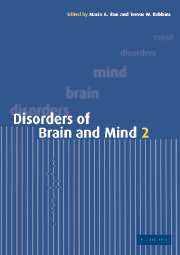Book contents
- Frontmatter
- Contents
- List of contributors
- Preface
- Part I Genes and behaviour
- Part II Brain development
- Part III New ways of imaging the brain
- 5 New directions in structural imaging
- 6 The application of neuropathologically sensitive MRI techniques to the study of psychosis
- Part VI Imaging the normal and abnormal mind
- Part V Consciousness and will
- Part IV Recent advances in dementia
- Part VII Affective illness
- Part VIII Aggression
- Part IX Drug use and abuse
- Index
- Plate section
- References
6 - The application of neuropathologically sensitive MRI techniques to the study of psychosis
from Part III - New ways of imaging the brain
Published online by Cambridge University Press: 19 January 2010
- Frontmatter
- Contents
- List of contributors
- Preface
- Part I Genes and behaviour
- Part II Brain development
- Part III New ways of imaging the brain
- 5 New directions in structural imaging
- 6 The application of neuropathologically sensitive MRI techniques to the study of psychosis
- Part VI Imaging the normal and abnormal mind
- Part V Consciousness and will
- Part IV Recent advances in dementia
- Part VII Affective illness
- Part VIII Aggression
- Part IX Drug use and abuse
- Index
- Plate section
- References
Summary
Introduction
Magnetic resonance imaging (MRI) has become the technique of choice to study subtle structural brain abnormalities and its value is well established in psychiatric research. Early studies aimed at detecting diffuse volumetric changes in patient populations have recently been superseded by advances in image analysis (e.g. voxel-based morphometry) that make it possible to detect minor, but functionally significant, focal volumetric changes (see Chapter 5 by Chitnis and Ellison-Wright). The yield of conventional MRI for psychiatry is not yet exhausted, but even with the help of sophisticated methods of image analysis some drawbacks will always limit its value. The first of these drawbacks is the lack of pathological specificity that makes it impossible to separate such diverse pathological processes as oedema, inflammation or gliosis. The second, especially relevant to psychiatry, is the fact that neuropathological abnormalities, whether developmental or degenerative, can be detected only when they are severe enough to cause loss of volume. These limitations make the use of these MRI techniques compelling, because of their potential to provide more specific neuropathological information and their ability to detect abnormalities invisible on conventional MRI. The two main techniques are magnetization transfer imaging (MTI) and diffusion tensor imaging (DTI). Here we describe these techniques, the neuropathological insights they can provide and their application to the study of psychiatric disease, schizophrenia in particular.
- Type
- Chapter
- Information
- Disorders of Brain and Mind , pp. 128 - 148Publisher: Cambridge University PressPrint publication year: 2003

